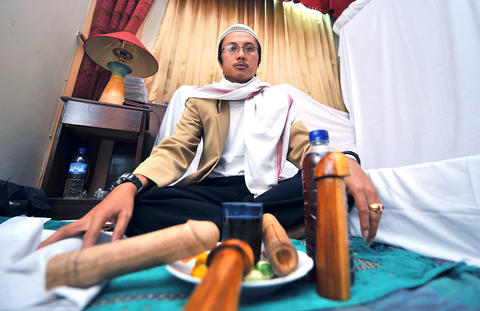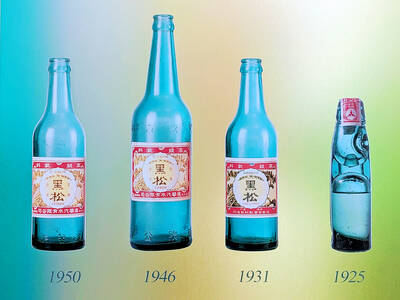Three large wooden penises lie on a colorful batik prayer mat in the house of Mak Erot, Indonesia's legendary lengthener of male members, inviting customers to pick their new look.
Mak Erot, the undisputed national expert in solving the self-image problems of Indonesian men, seems to have disappeared a long time ago but many believe she is still working her magic, perhaps from beyond the grave.
The craggy, betel nut-chewing woman with a distinctive brown birthmark on her cheek has spawned legions of imitators, while her legitimate heirs are keen to keep up the facade that she's alive lest business die with her.

PHOTO :AP
And it is a booming business - as a glance at the classified pages of any Indonesian tabloid newspaper will attest, packed as they are with ads for "penile paranormals" all claiming to have been trained by Mak Erot.
Jakarta, the nation's capital, even has a Mak Erot "clinic."
She has made it into popular culture too, with the film Extra Large: Between Me, You and Mak Erot currently playing in cinemas.
Mak Erot's village of Caringin is at the end of a road that winds along the Indian Ocean coast in southwestern Java. Her white house sits in a region where farmers from Indonesia's Sundanese culture incorporate their ancient animistic beliefs with Islam.
As expected, the disciples at Mak Erot's house say she's still alive.
"Mak Erot went to open an office in Medan (North Sumatra)," says a young man wearing a traditional Muslim beanie. "She's in a good shape. She still can walk."
He introduces himself as Haji Baban, Mak Erot's grandson, an heir of the old woman's esoteric powers and expertise in rare plants.
"People from all over the world come here, from Arab countries, from China, Singapore, Korea, Malaysia, Taiwan," he says.
"They want solutions to impotence or premature ejaculation, they ask to have a longer penis."
According to the daily Kompas, Mak Erot passed on her "science" to her five children and sixteen grandchildren who account for her 21 true heirs, a select order of masters of male enhancement.
A consultation with Haji Baban is an encounter with the arcane. Sitting cross-legged in semi-darkness, the patient is asked to detail his wishes with the visual aid of a selection of carved wooden phalluses.
Then comes the diagnosis, delivered after a contemplative silence.
Solemnly, Haji Baban intones that the client's appendage is "fairly average," and offers to conjure up a 6cm extension.
The prescription for such whopping growth is a 10-day course of eating and drinking mystery concoctions and secret potions, with the first dose of bitter berries to be taken immediately, washed down with dark brown liquid.
An assistant then brings a phallus shaped bamboo tube containing a roll of sticky coconut rice that has to be swallowed whole to avoid what Haji Baban describes ominously as "terrible genital consequences."
Haji Baban ends the consultation with a vegetable oil that the client must promise to apply daily with a specific hand action from base to tip. And no eating green bananas or citronella, he orders.
The daily cost for treatment is between US$70 and US$100, depending on the options selected.
This is a hefty sum for many in Indonesia but the imposing mansions being built around Caringin seem to indicate that plenty of men are willing to pay.
A local motorcycle taxi driver gestures to the newly built homes and says: "They belong to Mak Erot."

Behind a car repair business on a nondescript Thai street are the cherished pets of a rising TikTok animal influencer: two lions and a 200-kilogram lion-tiger hybrid called “Big George.” Lion ownership is legal in Thailand, and Tharnuwarht Plengkemratch is an enthusiastic advocate, posting updates on his feline companions to nearly three million followers. “They’re playful and affectionate, just like dogs or cats,” he said from inside their cage complex at his home in the northern city of Chiang Mai. Thailand’s captive lion population has exploded in recent years, with nearly 500 registered in zoos, breeding farms, petting cafes and homes. Experts warn the

The unexpected collapse of the recall campaigns is being viewed through many lenses, most of them skewed and self-absorbed. The international media unsurprisingly focuses on what they perceive as the message that Taiwanese voters were sending in the failure of the mass recall, especially to China, the US and to friendly Western nations. This made some sense prior to early last month. One of the main arguments used by recall campaigners for recalling Chinese Nationalist Party (KMT) lawmakers was that they were too pro-China, and by extension not to be trusted with defending the nation. Also by extension, that argument could be

Aug. 4 to Aug. 10 When Coca-Cola finally pushed its way into Taiwan’s market in 1968, it allegedly vowed to wipe out its major domestic rival Hey Song within five years. But Hey Song, which began as a manual operation in a family cow shed in 1925, had proven its resilience, surviving numerous setbacks — including the loss of autonomy and nearly all its assets due to the Japanese colonial government’s wartime economic policy. By the 1960s, Hey Song had risen to the top of Taiwan’s beverage industry. This success was driven not only by president Chang Wen-chi’s

Last week, on the heels of the recall election that turned out so badly for Taiwan, came the news that US President Donald Trump had blocked the transit of President William Lai (賴清德) through the US on his way to Latin America. A few days later the international media reported that in June a scheduled visit by Minister of National Defense Wellington Koo (顧立雄) for high level meetings was canceled by the US after China’s President Xi Jinping (習近平) asked Trump to curb US engagement with Taiwan during a June phone call. The cancellation of Lai’s transit was a gaudy